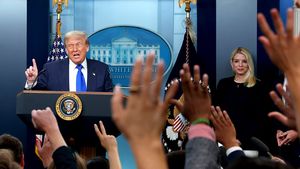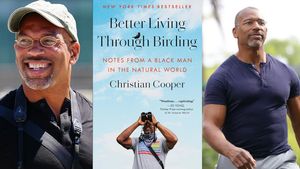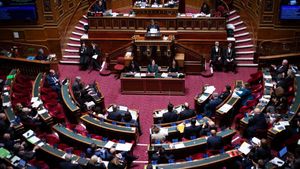"It's always been about the face."
Calling in from her home in Manila, Regine David is on the phone attempting to explain her approach to photography. "The body and clothes are secondary. I've always been interested in the emotion that they can give." It's an approach that has served the Filipino artist well in the years since she began sharing her work on social media.
Related | 38 Stunning Photos of Regine David's Queer Cast of Friends
The photos she has created in the past few years are at once both voyeuristic and vulnerable; her emotionally stripped down subjects gazing into the lens from bathtubs and hotel bedrooms. It's no shock when, midway through our phone call, the names of Steven Klein and Matt Lambert are floated as influences. These photographers have also developed an eye for capturing emotional vulnerability, but David's journey followed a different path.
After growing up in the Philippines, she left the conservative, Catholic country for the Savannah College of Art and Design. As she studied photography, she began traveling from Hong Kong to France to New York, using the college's satellite campuses to expand her craft. After graduating, she moved permanently to New York, working for everyone from Dazed and Urban Outfitters to Apple and Vogue Hommes.

James-Marlon.
It was in the city, far removed from the "surface-level pretty and commercial" boys of the Philippines, that met a cast of friends whose experimentation with self-image and sexuality stirred up her interest in finding the vulnerability in her subjects. "It started out with a lot of test shoots," she recalled of these early days. "It's the personality that matters to me. A pretty boy is nothing if he doesn't have any personality."
Two years ago, David moved from the breakneck pace of the city back to the Philippines and settled into Manila. She's become a witness to the city's burgeoning queer community and, earlier this month, saw the slow burn buildup culminate in a groundbreaking new gallery show called 'Swoon,' on display through October 26th at the Tarzeer Pictures Gallery. Handpicked as one of the eight Filipino photographers for the show by the new creative content production house, David's raw portraiture has made its way from the internet to the gallery.
As she took a break from listening to the sounds of local artist Jason Dhakal and scrolling Decor Hardcore's Instagram feed, we caught up with the photographer to talk about her favorite image and her favorite image, Manila's creative climate, and cum crocodile tears.

Mackenzie.
OUT: You're featured in a new exhibition by Tarzeer Pictures called 'Swoon' in Manila. How did you get involved with that?
Regine David: Tarzeer Pictures is a new production house in the Philippines, and a lot of them used to work in the United States. One of them, [Dinesh Mohnani], used to be at MATTE Projects and they decided to have something similar in the Philippines.
It's cool because we don't really have a strong photographic community here and having our kind of work shown in that context has been really overwhelming. Nobody has either the funds or the appreciation for that kind of work. We just had our launch and it was a huge turnout. Some people, including me, sold some of our stuff, which is crazy to me. I wouldn't expect that kind of work to be selling in a place like the Philippines.
What's the creative climate like there right now?
Like any other creative community, it's struggling. It's a lot tougher compared to other places like the U.S. or Europe or even Japan. We have a lot of frustrated artists--myself included. This gallery is a really good avenue for us to show our personal work that wouldn't be picked up by anyone. It's a turning point for a lot of us.
Do you think that people tend to ignore Asian-based artists in Western culture?
I would say yeah. I've noticed with a lot of exhibitions and features, we're looked over. I would consider myself a queer person of color Asian artist and whenever I would see lists of female photographers or even just photographers, we don't get much exposure. It didn't matter as much in New York when I was working there but when I'm outside of it, I see we're not given that much attention--or if it is, it's dealing with Asian culture. We can do work without it having an Asian influence.

Dane.
What is the queer scene like in Manila and the Philippines?
It's a lot more exciting now than it used to be. Queer acceptance wasn't strong when I was growing up. We finally have publications that cater to the LGBTQ community and have bills that support gay rights, which is something we're still fighting for. Yes, there are still issues, but at the same time, we're getting a lot of exposure.
How long have you been in Manila?
I moved back here May 2016. I grew up in the Philippines but moved abroad for school [at Savannah College of Art and Design] in 2010. We had campuses all over so I hopped around and lived in Hong Kong, Georgia, France, and New York. I was on a scholarship so it was much easier--I couldn't afford it without it! I moved back in 2016 and it was definitely a culture shock.
Tell me about the guys in your photos. How'd you pick them to photograph?
It started out with a lot of test shoots. It's the personality that matters to me. A pretty boy is nothing if he doesn't have any personality. Most of them have actually been people I photographed once or twice and then we became really good friends. People like Dane Bell, I photographed once and then we became really good friends, especially when we reconnected in Tokyo. I love him. He's the best.
Mainly they've been people I worked with once, and then we just had a really good relationship moving forward and decided to do more personal work outside of fashion or in the context of working.
The photo of Turner in the bathtub has become one of your most famous images. How did that photo come about?
I'd been shooting Turner for two years. Most of these, they're just me and the model. So for this shoot, I hadn't seen him or my friend August for about a year. This was in Tokyo last year and we got a bottle of wine and had fun. Played some music. It was such an uncontrolled environment that we just did whatever. There was nobody dictating how it looked.

Turner.
Is there an artist or photograph that made you want to pursue art when you were younger?
I can't think of one right now. There are a lot of people that I really admire but it changes depending on where I am in my life. There was a time when I really fell in love with the work of Steven Klein and Robert Mapplethorpe. You won't see that kind of work in my photographs but the inspiration is there. Then, of course, there are a lot of contemporaries like Matt Lambert that I really admire.
Related | Matt Lambert's Short Film, Flower, Finds Intimacy in Sex & Friendship
I photograph a lot of men because I grew up in a very conservative Catholic country so men were always surface-level pretty and commercial, but then I go to New York and people are a lot more open with themselves and their sexuality. That's what drew me into photographing people who are a lot more vulnerable.
Your photos feel like a peek behind clothes doors. We see these boys as they want to be seen, in a way they might not be able to express in public.
Yeah, I've always considered how they would feel about the image. You know how a lot of photographers are selfish and want a particular image? There is a lot of control in the way we shoot them. That's the way Ren Hang used to do it. He would position them in such a way that they were his canvas.
For me, I always try to get to know the person before I photograph them. When I would shoot, we'd take an hour to have some coffee and talk. It's still my projection but I want to let in their own personality in the work.
Yeah, otherwise you could be photographing anyone for the same image.
Exactly.
You have such a distinct style of shooting. Do you have any guidelines you try to use for yourself?
It's always been about the face. The body and clothes are secondary. I've always been interested in the emotion that they can give. I love that vulnerability and seeing them be comfortable in their sexuality or gender.

Vin.
I'm curious if you feel a pressure to constantly create new work given how fast-paced society has become with the rise of social media and the internet.
I used to. When I was in New York, yes absolutely. There were so many things happening and I'm sure you felt the same way when you were living there. If you didn't shoot or didn't go out, you were missing out. That anxiety was there, but now that I live here, the pressure isn't as strong as it used to be.
Because the Philippines isn't necessarily the most open-minded place, I find it very hard to find people who are down to shoot the same way that I did in New York. There are definitely amazing people I've met here but they are few and far between. What I do a lot here is just exist and work and stay home watching Netflix, then when I travel, that's when I go crazy and shoot a million things. I have a huge archive of work that I haven't posted yet that I release when I feel like it.
It's crazy living in places like New York and then moving away from it to somewhere like Manila or Berlin. You see that the pressure is insane and not conducive to a healthy artistic environment, especially if you always feel like you're competing with everyone.
I don't want to feel that pressure that you finish something and it has to go out immediately. I want to be able to take the time to reevaluate my work and see what I like about it. That's the kind of freedom you can get from places outside of New York.
Do you have a favorite image you've taken?
Oh god, that's so hard. It always changes. I do love my crying image of Reid. It's one of the close-up shots. I've been doing the whole tear series for over five years and I always thought it was funny to do crocodile tears. It's this exaggerated, fantasy-style tear. It's dual purpose--it looks like tears and looks like cum. I love it.

Reid.












































































